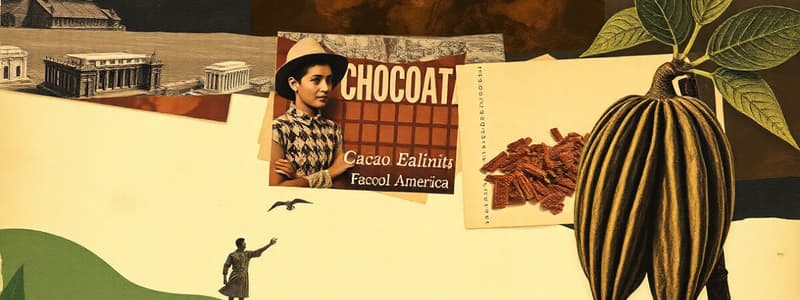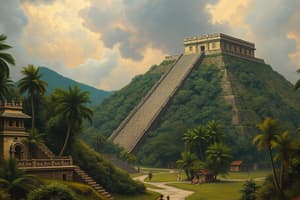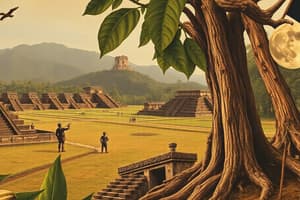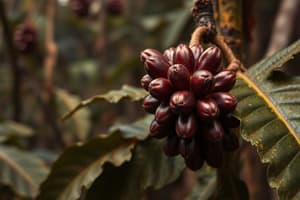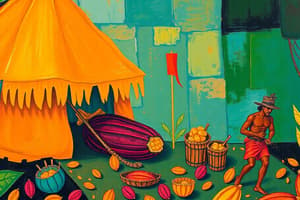Podcast
Questions and Answers
Before the 16th century, where was chocolate primarily consumed?
Before the 16th century, where was chocolate primarily consumed?
- Mesoamerica (correct)
- Europe
- Asia
- Africa
What ingredients did Mesoamericans typically combine with ground cacao beans to create their chocolate drink?
What ingredients did Mesoamericans typically combine with ground cacao beans to create their chocolate drink?
- Cornmeal and chili peppers (correct)
- Honey and vanilla
- Cinnamon and nutmeg
- Milk and sugar
Which of these describes the beliefs of Mesoamericans regarding cacao?
Which of these describes the beliefs of Mesoamericans regarding cacao?
- A source of bitterness
- A heavenly food from a feathered serpent god (correct)
- A simple trade good
- A mundane and common food
In Aztec society, what practical application did cacao beans serve, beyond being a component of a beverage?
In Aztec society, what practical application did cacao beans serve, beyond being a component of a beverage?
What context describes the first encounter of chocolate by Europeans?
What context describes the first encounter of chocolate by Europeans?
How did missionaries influence chocolate's reputation upon its arrival in Europe?
How did missionaries influence chocolate's reputation upon its arrival in Europe?
What was the initial perception of Chocolate when it was first introduced to Europe?
What was the initial perception of Chocolate when it was first introduced to Europe?
What alteration transformed chocolate into a beloved delicacy within the Spanish court?
What alteration transformed chocolate into a beloved delicacy within the Spanish court?
Which of the following statements describes chocolate production during its early introduction to Europe?
Which of the following statements describes chocolate production during its early introduction to Europe?
How did Coenraad van Houten's invention impact chocolate production?
How did Coenraad van Houten's invention impact chocolate production?
What innovation did Daniel Peter bring about in the realm of chocolate making?
What innovation did Daniel Peter bring about in the realm of chocolate making?
How did chocolate's status change by the 20th century?
How did chocolate's status change by the 20th century?
What climate is necessary for cocoa cultivation?
What climate is necessary for cocoa cultivation?
Which region currently dominates global cocoa production?
Which region currently dominates global cocoa production?
What proportion of the world's cocoa supply did Cote d'Ivoire provide as of 2015?
What proportion of the world's cocoa supply did Cote d'Ivoire provide as of 2015?
Which of the following is a major ethical concern in West African cocoa production?
Which of the following is a major ethical concern in West African cocoa production?
Approximately how many children are estimated to be involved in labor on cocoa plantations in West Africa?
Approximately how many children are estimated to be involved in labor on cocoa plantations in West Africa?
What role does chocolate play in present-day culture?
What role does chocolate play in present-day culture?
What perception does chocolate retain in modern times?
What perception does chocolate retain in modern times?
How did the Aztecs typically consume chocolate?
How did the Aztecs typically consume chocolate?
Flashcards
Original Chocolate Location
Original Chocolate Location
Before the 16th century, chocolate was exclusively found and utilized in Mesoamerica.
Mesoamerican Cacao Preparation
Mesoamerican Cacao Preparation
As far back as 1900 BCE, Mesoamericans prepared cacao beans, grinding and mixing them with cornmeal and chili peppers for a bitter drink.
Cacao's Divine Origin
Cacao's Divine Origin
They believed cacao was a heavenly food gifted to humans by a feathered serpent god, known as Kukulkan by the Maya and Quetzalcoatl by the Aztecs.
Cacao Bean Currency
Cacao Bean Currency
Signup and view all the flashcards
First Transatlantic Chocolate Encounter
First Transatlantic Chocolate Encounter
Signup and view all the flashcards
Chocolate's Aphrodisiac Reputation
Chocolate's Aphrodisiac Reputation
Signup and view all the flashcards
Sweetened Chocolate's Popularity
Sweetened Chocolate's Popularity
Signup and view all the flashcards
Chocolate's Labor Source
Chocolate's Labor Source
Signup and view all the flashcards
Cocoa Press Inventor
Cocoa Press Inventor
Signup and view all the flashcards
Milk Chocolate Inventor
Milk Chocolate Inventor
Signup and view all the flashcards
Modern Cocoa Production Region
Modern Cocoa Production Region
Signup and view all the flashcards
World's Largest Cocoa Producer
World's Largest Cocoa Producer
Signup and view all the flashcards
Ethical Concerns in Cocoa Production
Ethical Concerns in Cocoa Production
Signup and view all the flashcards
Study Notes
- Chocolate was exclusive to Mesoamerica before the 16th century.
- Cacao beans were prepared by Mesoamericans as early as 1900 BCE.
- The beans were ground, mixed with cornmeal and chili peppers, creating a bitter beverage.
Mesoamerican Chocolate Culture
- Mesoamericans considered cacao a divine food bestowed by a feathered serpent god.
- The Maya referred to the god as Kukulkan, while the Aztecs knew him as Quetzalcoatl.
- Aztecs utilized cacao beans as a form of currency.
- Aztecs consumed chocolate during royal feasts.
- Chocolate was a reward given to soldiers for success in battle.
- Chocolate was part of rituals.
Introduction to Europe
- The initial transatlantic encounter with chocolate occurred in 1519 when Hernán Cortés met Moctezuma.
- The king presented 50 jugs of the drink, served in golden cups.
- Accounts from missionaries regarding native customs contributed to chocolate's reputation as an aphrodisiac.
- Chocolate's bitter flavor made it a suitable medicine for various ailments.
- Sweetening chocolate with honey, sugar, or vanilla transformed it into a popular delicacy in the Spanish court.
- Aristocratic residences possessed dedicated chocolate ware.
- Chocolate production necessitated plantations and the importation of slave labor in the Caribbean and islands off the African coast.
Industrial Revolution
- The cocoa press was introduced in 1828 by Coenraad van Houten of Amsterdam.
- Van Houten's invention separated the cocoa's natural fat, known as cocoa butter.
- A powder remained that was mixed into a drinkable solution or reunited with cocoa butter to form solid chocolate.
- Daniel Peter, a Swiss chocolatier, invented milk chocolate by adding powdered milk to the mix.
- By the 20th century, chocolate transitioned from an elite luxury to a treat accessible to the public.
Modern Day
- Meeting chocolate demand necessitated increased cocoa cultivation, limited to regions near the equator.
- Cocoa production relocated to West Africa.
- As of 2015, Cote d'Ivoire supplies two-fifths of the world's cocoa.
- Numerous plantations in West Africa employ slave and child labor.
- Over 2 million children are estimated to be affected.
- Chocolate has become integrated into rituals of modern culture.
- Chocolate maintains an image of sensuality, decadence, and being forbidden.
Studying That Suits You
Use AI to generate personalized quizzes and flashcards to suit your learning preferences.
